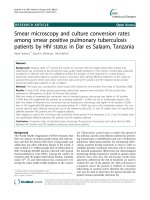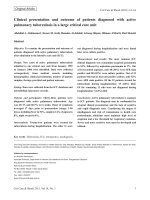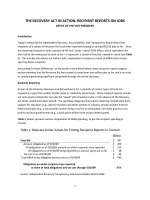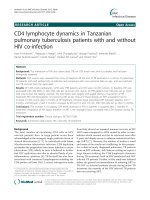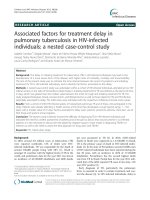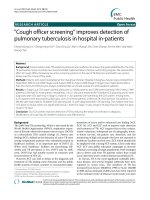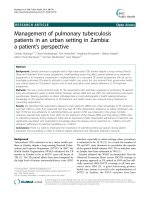Scanning Laser Polarimetry in Pulmonary Tuberculosis Patients on Chemotherapy pdf
Bạn đang xem bản rút gọn của tài liệu. Xem và tải ngay bản đầy đủ của tài liệu tại đây (30.82 KB, 5 trang )
June 2006, Vol. 35 No. 6
395SLP in Pulmonary Tuberculosis Patients on Chemotherapy—Wilson WT Tang et al
Scanning Laser Polarimetry in Pulmonary Tuberculosis Patients on Chemotherapy
Wilson WT Tang,
1
MRCSEd, MMed (Ophth), Jimmy SM Lai,
2,3
FRCOphth, MMed (Ophth), MD, Clement CY Tham,
3
FRCS,
Kam-Keung Chan,
4
FHKCP, Kin-Sang Chan,
4
FRCP
Introduction
Pulmonary tuberculosis is a worldwide disease. In Hong
Kong, there are about 7000 new cases of pulmonary
tuberculosis each year and the prevalence remains high at
about 110/100,000.
1,2
The male elderly (>60 years) are at
the greatest risk.
3
The consensus treatment regime in Hong
Kong consists of a 6-month multi-drug course of
chemotherapy under directly observed treatment (DOTS).
4
The recommended regime in the treatment of uncomplicated
pulmonary tuberculosis cases comprises 2 months’
treatment with isoniazid, rifampicin, pyrazinamide together
with streptomycin or ethambutol, followed by 4 months of
isoniazid and rifampicin.
Although chemotherapy is highly effective, it has its own
risks. Ethambutol and isoniazid have been associated with
toxic optic neuropathy.
5
Although this ocular complication
is relatively uncommon, the toxic effect can be severe and
irreversible. Even with the prompt cessation of ethambutol,
visual recovery is expected in only half of the patients. In
the older age group, only one-fifth of patients experienced
visual improvement.
6
Apart from clear verbal instruction to
patients to cease medications once visual symptoms occur,
the current preventive measure is to perform regular
ophthalmological assessment. Toxic optic neuropathy is
diagnosed clinically when patients present with deteriorating
vision, impaired colour vision and visual field changes.
7
Nevertheless, a significant portion of patients with
ethambutol-related toxic optic neuropathy still suffers from
permanent poor visual outcome followed by optic atrophy.
8
In order to achieve earlier detection of toxic optic
neuropathy, the use of electrophysiological tests, such as
visual evoked potential (VEP), have been studied in human
subjects.
9
In 6 of the 14 patients taking ethambutol,
subclinical changes in the latency and amplitude of the
P100 component in pattern reversal VEP were demonstrated
1
Department of Ophthalmology, Tseung Kwan O Hospital, Kowloon, Hong Kong
2
Department of Ophthalmology, United Christian Hospital, Kowloon, Hong Kong
3
Department of Ophthalmology and Visual Sciences, The Chinese University of Hong Kong, Hong Kong
4
Department of Medicine, Haven of Hope Hospital, Tseung Kwan O, Hong Kong
Address for Reprints: Dr Jimmy SM Lai, Department of Ophthalmology, United Christian Hospital, Hip Wo Street, Kwun Tong, Kowloon, Hong Kong.
Email:
Abstract
Introduction: The aim of this study was to analyse the thickness of the retinal nerve fibre layer
(RNFL) of pulmonary tuberculosis patients on ethambutol and isoniazid.
Materials and Meth-
ods: This was a prospective cohort study where patients with newly diagnosed pulmonary
tuberculosis requiring chemotherapy, including ethambutol and isoniazid, were imaged using
scanning laser polarimetry. Their mean baseline RNFL thickness and various scanning laser
polarimetry parameters of both eyes were measured 2 weeks after the commencement of
chemotherapy. The measurements were repeated at 3 months and 6 months after treatment. The
various parameters of the baseline and the follow-up measurements were compared using paired
sample t-test with Bonferroni correction.
Results: Twenty-four patients (16 males and 8 females;
mean age, 51.0 ± 17.6 years) were recruited. There was no statistically significant difference
between the baseline and the follow-up measurements in RNFL thickness and all other scanning
laser polarimetry parameters.
Conclusion: In this cohort of subjects, there was no subclinical
change in RNFL thickness detected by scanning laser polarimetry in pulmonary tuberculosis
patients on chemotherapy, including ethambutol and isoniazid, after 6 months of treatment.
Ann Acad Med Singapore 2006;35:395-9
Key words: Drug toxicity, Ethambutol, Isoniazid, Lasers, Optic diseases, Retina, Tuberculosis
Original Article
396
Annals Academy of Medicine
SLP in Pulmonary Tuberculosis Patients on Chemotherapy—Wilson WT Tang et al
after 1 to 3 months of treatment. These changes were
reversed in only half of the patients after the cessation of
treatment. Based on this finding, early detection of any
subclinical change in retinal nerve fibre layer (RNFL)
thickness may be useful for earlier detection of ethambutol-
related optic neuropathy, before optic atrophy occurs. In a
recent study, detectable changes in peripapillary RNFL
thickness were documented in 3 patients with known
history of ethambutol-induced optic neuropathy by the use
of optical coherence tomography.
10
However, subclinical
structural changes in RNFL thickness have not been studied
in clinically asymptomatic human subjects receiving
ethambutol and isoniazid.
Various new technologies have evolved over the recent
decade to investigate RNFL, including scanning laser
polarimetry (SLP) and optical coherence tomography. The
nerve fibre analyser (NFA) is a confocal scanning laser
ophthalmoscope with an integrated polarimeter that
indirectly assesses the thickness of the RNFL objectively
based on retardation of polarised light due to the birefringent
properties of microtubules of the nerve fibres.
11
It has
been used for quantitative measurement of RNFL thickness
in patients with ocular hypertension and primary open-
angle glaucoma.
12-15
As the measurement procedure is fast
and objective, it is ideal for elderly patients who find the
visual field test difficult. This study is focused on the
detection of subclinical RNFL thinning using the NFA in
pulmonary tuberculosis patients on the standard
chemotherapy regime.
Materials and Methods
This was a prospective cohort study in which the RNFL
measurements of patients who had been under treatment
for pulmonary tuberculosis were documented in subsequent
follow-up sessions. Ethambutol-induced optic neuropathy
was defined clinically by unexplained decrease in vision,
colour vision impairment, abnormal fundal examination or
visual field abnormality in patients receiving ethambutol.
Between May 2001 and November 2002, all patients
with newly diagnosed pulmonary tuberculosis requiring
standard recommended chemotherapy, including both
ethambutol (15 mg/kg to 25 mg/kg) and isoniazid (5 mg/
kg), were recruited from the Department of Medicine,
Heaven of Hope Hospital. Patients with pre-existing optic
nerve diseases, retinopathy of all causes, previous ocular
trauma, glaucoma, operation or laser procedure as well as
those taking concurrent, potentially neurotoxic medications
e.g., amiodarone, were excluded from the study to avoid
their confounding effects on RNFL measurements.
A protocol of standardised ophthalmological assessment,
which was approved by the Ethics Committees of the
Chinese University of Hong Kong and the United Christian
Hospital, was performed on each subject. An informed
consent form was signed by every studied patient.
Recruited subjects had their baseline RNFL thickness
measured using the GDx NFA (Laser Diagnostic
Technologies, Inc, San Diego, CA, USA) 2 weeks after the
commencement of chemotherapy. This time point was
chosen for the baseline measurement because the contagion
of mycobacterium tuberculosis is rapidly lowered after the
commencement of chemotherapy and optic neuropathy
seldom occurs within 2 weeks of treatment. Moreover, in
one study involving 13 patients having ethambutol-related
toxicity, optic neuro-pathy developed 1 to 6 months (mean,
2.9) after starting treatment.
16
Thus, we repeated RNFL
measurement at 3 months after treatment in this study.
Furthermore, since ethambutol toxicity is known to be
dose-related, delayed toxicity is not expected after the
cessation of treatment.
17
RNFL measurement was therefore
repeated at 6 months after treatment when all patients had
completed their treatment.
Although variable corneal compensation that would
eliminate incomplete compensation among those anterior
segment outliers was not available in the GDx model used
in this study, this is not a significant issue in this longitudinal
comparative study design. Three pictures with passing
grade of the image quality were taken for each eye. The one
with the best image quality, as interpreted and quantified by
the software (version 1.0.05) generated image quality
table, together with the lack of motion artifacts as shown on
the nerve fibre layer thickness map, was chosen for further
analysis. An extended nerve fibre analysis table including
various parameters was generated for each eye. The
parameters for analysis include symmetry, superior ratio,
inferior ratio, superior/nasal ratio, maximum modulation,
ellipse modulation, the number, average thickness, ellipse
average, superior average, inferior average and superior
integral. During each follow-up, patients also had visual
acuity test, intraocular pressure (IOP) measurement, slit-
lamp and fundal examination and colour vision test (Ishihara
plates) documented. Automated Humphrey threshold visual
field test [C-24(2)] (Humphrey Field Analyzer HFA 750,
Humphrey Instruments, Dublin, CA, USA) was also
performed during each visit. Unreliable results, defined as
fixation loss of >20% and/or false positive and/or false
negative of >30%, were excluded.
All the examinations and investigations were mainly
performed by one experienced operator. Upon completion
of data collection over the 6-month period, the various
parameters of the GDx NFA of the baseline and the follow-
up measurements were compared using the paired sample
t-test with Bonferroni correction. A P value of <0.05 was
considered statistically significant.
June 2006, Vol. 35 No. 6
397SLP in Pulmonary Tuberculosis Patients on Chemotherapy—Wilson WT Tang et al
Results
A total of 41 patients with newly diagnosed pulmonary
tuberculosis who had been treated with the standard
recommended chemotherapy regime were recruited. Among
those subjects, 17 were excluded due to various reasons.
These include defaulting follow-up over the 6-month study
period (14 subjects), poor NFA image quality due to
markedly tilted optic discs (1 subject) and cataract (1 eye of
a subject), incidental finding of branch retinal vein occlusion
(1 subject) and termination of ethambutol by physicians
due to a subjective drop in vision (1 subject).
The recruited subjects all had normal optic disc, macula
and baseline SLP scan findings. For the patient who
complained of a subjective drop in vision, no optic
neuropathy was diagnosed clinically upon regular follow-
up, with stable visual acuity, normal colour perception and
no visual field change. RNFL analysis performed at 3
months and 6 months after chemotherapy in this patient
revealed no progressive change in any of the measured
parameters either.
A total of 24 patients (47 eyes) completed the study. The
ages of the 16 male and 8 female subjects ranged from 20
years to 78 years [mean, 51.0 ± standard deviation (SD)
17.6]. Two recruited subjects had congenital red-green
colour deficiency. The range of Snellen visual acuity, and
the mean IOP, 2 weeks and 3 months after treatment was
0.2 to 1.0, and 14.0 mm Hg, respectively. After a 6-month
period of treatment, their Snellen visual acuities ranged
from 0.3 to 1.0 while the mean IOP was 13.6 mmHg. All
subjects had normal IOP throughout the study.
Among the 24 subjects included, only 8 subjects produced
reliable visual field results in all 3 measurements for
interpretation. Although visual field testing was repeated
one more time during each measurement if the subject was
noted to produce an unreliable result after the first attempt,
9 subjects in total still had unreliable visual field results in
any one measurement while 7 subjects produced unreliable
results due to unacceptable fixation loss. All of them had
stable visual acuity and normal fundal examination. There
was no newly detected colour vision impairment. None of
the studied subjects developed toxic optic neuropathy
clinically throughout the study period. By comparing the
average of various parameters of NFA taken at 2 weeks, 3
months and 6 months after treatment by paired sample t-test
with Bonferroni correction (Table 1), no statistically
significant change was found in any of the NFA parameters
over the 6-month period of study (Table 2).
Discussion
Although toxic optic neuropathy caused by ethambutol is
rare, it is unpredictable, potentially severe and sometimes
irreversible. The neurotoxic effect of isoniazid may be
attributed to a relative pyridoxine deficiency but the exact
pathophysiological mechanism of ethambutol-related toxic
optic neuropathy remains unclear. However, the specific
toxicity of ethambutol to rodent retinal ganglion cell via an
excitotoxic pathway has been demonstrated in an animal
study.
18
Changes in P100 latency and amplitude of pattern
VEP were also noted in clinically asymptomatic human
subjects treated with ethambutol. Although pattern VEP
may be useful for detecting early changes in ethambutol-
related optic neuropathy, this electrophysiological test is
time-consuming, requires good patient cooperation and
dedicated investigative technique. Similarly, visual field
tests also require good patient concentration and
Table 1. GDx Measurements at Various Time Points during Anti-tuberculosis Treatment
Mean ± SD
NFA parameters Baseline 3 months post-treatment 6 months post-treatment
Symmetry 1.00 ± 0.14 1.00 ± 0.15 1.01 ± 0.16
Superior ratio 2.01 ± 0.58 2.04 ± 0.53 2.03 ± 0.53
Inferior ratio 2.01 ± 0.52 2.06 ± 0.52 2.04 ± 0.54
Superior/Nasal ratio 1.79 ± 0.43 1.78 ± 0.45 1.80 ± 0.48
Maximum modulation 1.26 ± 0.49 1.29 ± 0.45 1.29 ± 0.47
Ellipse modulation 2.43 ± 0.61 2.54 ± 0.68 2.55 ± 0.75
Number 40.83 ± 26.83 37.32 ± 24.26 37.11 ± 26.91
Average thickness 64.23 ± 11.78 63.49 ± 10.69 64.65 ± 10.38
Ellipse average 66.32 ± 13.08 66.47 ± 11.21 67.06 ± 11.47
Superior average 73.19 ± 16.56 72.79 ± 13.37 74.06 ± 15.47
Inferior average 76.30 ± 18.01 76.98 ± 15.65 77.23 ± 16.45
Superior integral 0.22 ± 0.04 0.22 ± 0.04 0.22 ± 0.04
Baseline measurement: taken at 2 weeks after treatment
398
Annals Academy of Medicine
SLP in Pulmonary Tuberculosis Patients on Chemotherapy—Wilson WT Tang et al
cooperation. This is also well demonstrated in this study, in
which only one-third of all subjects produced reliable
visual field results for diagnosing optic neuropathy. Since
detectable changes in peripapillary RNFL thickness were
reported in patients with known ethambutol-induced optic
neuropathy by the use of optical coherence tomography,
this study aims to investigate any subclinical changes in
RNFL thickness by the use of scanning laser polarimetry in
clinically asymptomatic patients. This investigation is more
objective and less time-consuming compared to pattern
VEP and automated perimetry. Its finding may be useful in
detecting early ocular toxicity of ethambutol and also has
an implication for the ocular safety of the current
recommended chemotherapy regime for treating pulmonary
tuberculosis.
This study allowed us to follow patients on ethambutol
and isoniazid longitudinally for a period of 6 months. The
problem with non-compliance to medications did not exist
because the treatment regime uses a direct observation
system to achieve 100% compliance. In this study, no
significant change in RNFL thickness was demonstrated in
any NFA parameter after a 6-month course of chemotherapy,
including 2 months’ treatment with ethambutol. Potential
confounding factors affecting RNFL measurements,
including pre-existing retinopathy or other optic neuropathy
such as glaucoma, were excluded early in the study.
Although it has been shown that there was positive
correlation between the degree of cataract and RNFL
measurements, which may mask any possible reduction in
RNFL thickness, significant cataract progression was
unlikely due to the relatively short period of study and
stable visual acuity among the patients during serial follow-
Table 2. P Values (with Bonferroni Correction) of GDx Measurement
Changes at Various Time Points during Anti-tuberculosis Treatment
P value (Two-tailed paired t-test)
NFA parameters Baseline - 2
nd
2
nd
- 3
rd
Baseline - 3
rd
measurements measurements measurements
Symmetry 2.808 2.574 2.355
Superior ratio 1.896 2.466 2.163
Inferior ratio 0.945 1.875 1.749
Superior/Nasal ratio 2.343 2.124 2.793
Maximum modulation 1.806 3.000 1.683
Ellipse modulation 0.831 2.589 0.594
Number 0.201 2.742 0.171
Average thickness 1.530 0.960 2.388
Ellipse average 2.715 1.731 1.686
Superior average 2.400 1.032 1.722
Inferior average 2.013 2.535 1.734
Superior integral 2.916 1.731 1.968
REFERENCES
1. Annual Report 2001 Tuberculosis & Chest Service of the Department
of Health. Hong Kong Government Tuberculosis and Chest Service
1971-2001.
2. Chan-Yeung M, Noertjojo K, Tan J, Chan SL, Tam CM. Tuberculosis in
the elderly in Hong Kong. Int J Tuberc Lung Dis 2002;6:771-9.
3. Tam CM, Leung CC, Noertjojo K, Chan SL, Chan-Yeung M. Tuberculosis
in Hong Kong – patient characteristics and treatment outcome. Hong
Kong Med J 2003;9:83-90.
4. Chemotherapy of tuberculosis in Hong Kong: a consensus statement.
The Tuberculosis Control Coordinating Committee (Department of
Health) and the Tuberculosis Subcommittee of the Coordinating
Committee in Internal Medicine (Hospital Authority), Hong Kong. Hong
Kong Med J 1998;4:315-20.
5. Jimenez-Lucho VE, del Busto R, Odel J. Isoniazid and ethambutol as a
cause of optic neuropathy. Eur J Respir Dis 1987;71:42-5.
6. Tsai RK, Lee YH. Reversibility of ethambutol optic neuropathy. J Ocul
Pharmacol Ther 1997;13:473-7.
7. Sivakumaran P, Harrison AC, Marschner J, Martin P. Ocular toxicity
from ethambutol: a review of four cases and recommended precautions.
N Z Med J 1998;111:428-30.
up.
19
To conclude, although prolonged latency and decreased
amplitude has been shown in patients receiving ethambutol,
no structural change in RNFL thickness suggestive of
structural damage was detected in this study by the use of
scanning laser polarimetry.
However, this study has certain limitations. First, the
sample size is relatively small for investigating a relatively
uncommon adverse RNFL drug-related effect. The small
sample size may result in insufficient power of this study to
detect structural change in RNFL thickness, especially if
the changes are subtle. Moreover, the true pre-treatment
RNFL measurement could not be obtained in this study
because of the risk of the investigator contracting this
highly infectious disease before commencement of
chemotherapy among the patients. A 2-week post-treatment
measurement was used as the baseline instead. Furthermore,
any possible delayed structural change in RNFL thickness
may have been missed as the RNFL measurement was
completed at 6 months.
In conclusion, in patients receiving ethambutol and
isoniazid without visual or colour vision impairment,
scanning laser polarimetry did not show any structural
change in the their RNFL thickness.
Proprietary Interest
GDx
®
is a registered trade mark of Laser Diagnostic Technologies, Inc
(San Diego, CA, USA), in which the authors have no financial interest.
Competing Interest
The authors have no financial interest in the anti-tuberculosis drugs in
this study.
June 2006, Vol. 35 No. 6
399SLP in Pulmonary Tuberculosis Patients on Chemotherapy—Wilson WT Tang et al
8. Kumar A, Sandramouli S, Verma L, Tewari HK, Khosla PK. Ocular
ethambutol toxicity: is it reversible? J Clin Neuroophthalmol 1993;13:15-7.
9. Yiannikas C, Walsh JC, McLeod JG. Visual evoked potentials in the
detection of subclinical optic toxic effects secondary to ethambutol.
Arch Neurol 1983;40:645-8.
10. Zoumalan CI, Agarwal M, Sadun AA. Optical coherence tomography
can measure axonal loss in patients with ethambutol-induced optic
neuropathy. Graefes Arch Clin Exp Ophthalmol 2005;243:410-6.
11. Weinreb RN, Dreher AW, Coleman A, Quigley H, Shaw B, Reiter K.
Histopathologic validation of Fourier-ellipsometry measurements of
retinal nerve fiber layer thickness. Arch Ophthalmol 1990;108:557-60.
12. Quigley HA, Dunkelberger GR, Green WR. Chronic human glaucoma
causing selectively greater loss of large optic nerve fibers. Ophthalmology
1988;95:357-63.
13. Sommer A, Miller NR, Pollack I, Maumenee AE, George T. The nerve
fiber layer in the diagnosis of glaucoma. Arch Ophthalmol 1977;95:
2149-56.
14. Weinreb RN, Shakiba S, Zangwill L. Scanning laser polarimetry to
measure the nerve fiber layer of normal and glaucomatous eyes. Am J
Ophthalmol 1995;119:627-36.
15. Tjon-Fo-Sang MJ, Lemij HG. The sensitivity and specificity of nerve
fiber layer measurements in glaucoma as determined with scanning laser
polarimetry. Am J Ophthalmol 1997;123:62-9.
16. Chuenkongkaew W, Samsen P, Thanasombatsakul N. Ethambutol and
optic neuropathy. J Med Assoc Thai 2003;86:622-5.
17. Leibold JE. The ocular toxicity of ethambutol and its relation to dose.
Ann N Y Acad Sci 1966;135:904-9.
18. Heng JE, Vorwerk CK, Lessell E, Zurakowski D, Levin LA, Dreyer EB.
Ethambutol is toxic to retinal ganglion cells via an excitotoxic pathway.
Invest Ophthalmol Vis Sci 1999;40:190-6.
19. Chiba T, Kogure S, Tsukahara S. Influence of cataract on scanning laser
polarimetry [Japanese]. Nippon Ganka Gakkai Zasshi 2000;104:626-
30.
